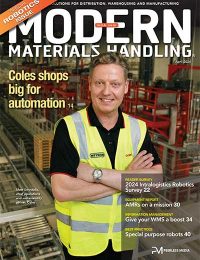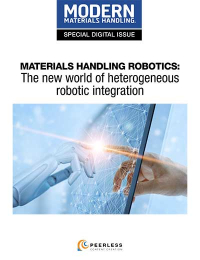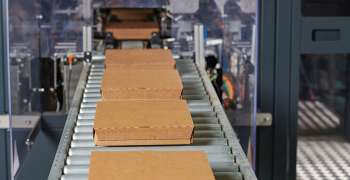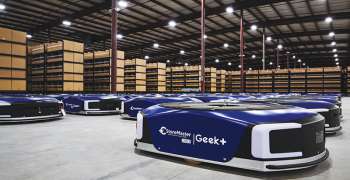Lift trucks: Brawn meets brains
Features and technology are enabling lift trucks to operate smarter and safer.
Latest Material Handling News
Radial stays ahead of the automation curve Wireless Mobility: Ready for the next leg up AGVs set new standards for inventory transportation Inside North Shore Care Supply: Bringing robots to receiving Bergen Logistics: Putting robots to work in a multi-tenant facility More Equipment ReportWhile the mechanical basics of lift truck design haven’t changed much over the years, there has been an increased demand for information that helps management measure expenses and productivity of each vehicle, says Brian Feehan, president of the Industrial Truck Association (ITA).
Manufacturers of lift trucks today are responding to customer needs by offering even higher levels of customization. “As the industry evolves, we are creating custom designs that are then available as optional equipment, and maybe standard equipment,” adds Jeff Rufener, president of Toyota Material Handling U.S.A.
This equipment report takes a look at some of the features that are enhancing lift truck safety, communicating vital information, performing tasks and working smarter.
Technology and metrics
Today’s lift trucks have a tremendous amount of technology to measure the overall cost of operations. The reason is simple: Sometimes reining in cost and optimizing performance is about the operator and not about the vehicle. “End users are looking at how to control the cost of labor and how to get more out of labor,” says Jonathan Dawley, president of Hyster Distribution. “If the equipment isn’t being used properly, the result could be damage to the facility or the product.”
There are many ways to get this information. For one, sensors can be applied to simply track truck movements and impact incidents. Or, for end users who want additional detailed information, you can require the truck operator to swipe an ID card on the truck’s terminal and successfully complete an OSHA checklist before they are allowed to operate the vehicle.
president of Hyster Distribution
Tracking and holding people accountable for their personal performance is important to the overall operation.
Another way to collect data is to install systems that track maintenance, parts and service. This way, managers can understand which piece of equipment is costing the most money.
This electronic monitoring may also enhance the overall safety of a fleet. For example, a truck with a bad light can be automatically removed from service within the system. It will only be allowed back into service after maintenance personnel have repaired the issue.
Whether the system is monitoring operators, equipment or both, there are multiple ways to communicate that information, Dawley explains. The system can hook into the facility’s Wi-Fi network, the customer can install a radio network to communicate with the fleet or a cellular-based device can be used to communicate with the trucks.
Productivity and picking power
Focusing on process and productivity became increasingly important during the economic downturn, says Maria Schwieterman, marketing product manager for Crown. “Customers needed to reduce costs and increase productivity, and lift truck manufacturers responded with features to help achieve those goals,” she says.
One specific example of that response is Crown’s automation of low-level order picking. The solution includes a pallet truck outfitted with a PC and a corresponding remote control button on a wireless transceiver glove or transceiver trigger worn by the operator. Once the operator picks the order and places it on the pallet, they remotely advance the pallet truck to the next pick location with the push of a button.
“When they turn around, they’re right where they need to be with the product and the truck is right where it needs to be,” explains Schwieterman. This solution saves the operator from repeatedly returning to the vehicle’s operator compartment, which can reduce the number of steps by about 70%.
Forklift scales
Efficiency is a common denominator in virtually every segment of the lift truck market. Not only do customers want more and more efficiency, they want to simplify the operator’s job, says Toyota’s Rufener. Additionally, he adds, customers are also asking manufacturers for more integrated capabilities and to move their products for less money.
Those requests can manifest themselves in a variety of solutions, including forklift scales that provide legal-for-trade weighing of loads up to 16,000 pounds. “In business, time is money,” says Don Halbert, global product manager for Avery Weigh-Tronix. “Traveling to a floor scale and waiting in line to weigh a load can be time consuming, while cutting corners by guessing the weight can cost businesses millions in revenue every year.”
Integrating a scale into a forklift can save time, money and labor as well as establish accurate invoicing. Once the lift truck picks up the load, bar weight sensors electronically measure the load on the forks and convey the information to an in-cab indicator. The in-cab instruments allow weight data to be recorded, displayed and transmitted wirelessly from the forklift to a back office collection system. Supervisors can monitor and manage freight arrival and shipments in real time, facilitating more accurate inventory and billing records.
The scale is attached to the existing forklift carriage and uses the forklift’s existing forks. If needed, the scale and instrument system can be moved to another truck in minutes.
Alternative power
Fuel cell technology is expanding as well. “Fuel cell technology is simple, it refers to an engine that runs on hydrogen and air,” explains Andy Marsh, CEO of Plug Power. While it’s been around a long time, Marsh says, it only reached a point of commercial availability around the 2008-2009 timeframe.
There are several benefits to fuel cell technology in materials handling:
-
Time saving: Fuel cell-powered lift trucks, which run at full power for the duration of a shift once charged, can be refueled in about 3 minutes, compared to about the 20 minutes it takes to swap out a lead acid battery;
-
Space saving: Because they don’t require a battery room or battery recharging equipment, about 5% of a DC’s floor space can be freed up;
-
Improve air quality: Fuel cells reduce green house gas emissions inside the DC by 80%, creating a cleaner environment for people and products.
-
Lower energy costs: One fuel cell can replace three lead acid batteries per forklift, eliminating electricity usage and costs.
Still, fuel cells are not right for every operation. The value proposition, according to Marsh, is realized when an operation has a fleet of between 35 and 50 lift trucks and where electricity costs are more than 8 cents per kilowatt hour—then this solution has a real value to the customer.
“The technology is making steady progress,” says Marsh. “Two or three years ago we had to convince people that fuel cells are a technology that work. Now, they’re convinced and the technology is gaining momentum.” In fact, Marsh says, “The ITA predicts that by the year 2025, 90% of forklift trucks will be powered by fuel cells.”

Article Topics
Equipment Report News & Resources
Radial stays ahead of the automation curve Wireless Mobility: Ready for the next leg up AGVs set new standards for inventory transportation Inside North Shore Care Supply: Bringing robots to receiving Bergen Logistics: Putting robots to work in a multi-tenant facility High-tech meets low-tech: Automate storage for pallet loads Tuggers, carts work together to increase productivity and ergonomics More Equipment ReportLatest in Materials Handling
Registration open for Pack Expo International 2024 Walmart chooses Swisslog AS/RS and software for third milk processing facility NetLogistik partners with Vuzix subsidiary Moviynt to offer mobility solutions for warehouses Materials Handling Robotics: The new world of heterogeneous robotic integration BSLBATT is looking for new distributors and resellers worldwide Lucas Watson appointed CSO for Körber’s Parcel Logistics business in North America Hyster recognizes Dealers of Distinction for 2023 More Materials HandlingAbout the Author
Subscribe to Materials Handling Magazine

Find out what the world's most innovative companies are doing to improve productivity in their plants and distribution centers.
Start your FREE subscription today.
April 2024 Modern Materials Handling

Latest Resources











